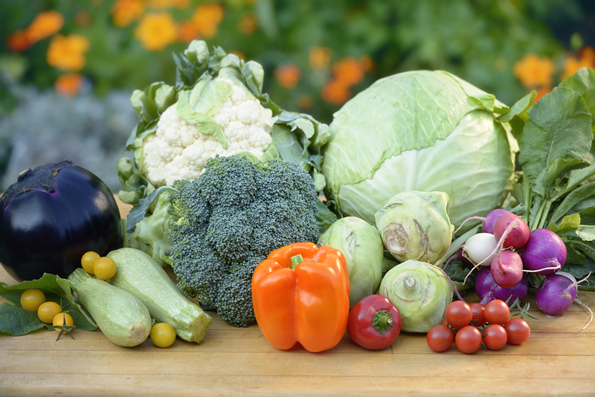Vegetable Gardening In San Diego
"To plant a garden is to believe in tomorrow."
-Audrey Hepburn

By Jodi Bay
Vegetable gardens have been and continue to be havens during difficult times. George Washington Carver promoted the idea of edible gardens in personal residences during times of war and coined the phrase 'Victory Garden'. Ever since, Victory Gardens arise during times of difficulties as a way to supplement meals with affordable and healthy produce and to boost morale. If you are new to vegetable gardening or need a refresher, here are a few topics to consider before digging in.
One of Stephen Covey's principles in "7 Habits of Highly Effective People" is "Begin with the end in mind". Essentially, create a vision of the end result prior to starting a project. Before planting, take time to figure out your garden goals: What do you want to grow? How much time is available to work in the garden? What size garden? Where will the garden be located? Who is involved in garden planning and maintenance? What supplies are needed? Defining the goals helps to set a clear path for success.
Plants need air, water, sun, nutrients and space. Select a site that has easy access to water and your home; healthy, rock and weed free soil (add compost if needed); and a minimum of 8 to 10 hours of sunlight in the summer and 6 to 8 hours in the winter. The garden can be in-ground, a raised bed, or a container. Observe the site during daytime making note of where and when the shadows appear. Windy areas, walls and fences, and slopes create their own weather called 'microclimates' which can influence how well the plants grow. Study the microclimatic conditions of the site before planting.
Vegetables are categorized as either 'Cool Season' or 'Warm Season'. In Southern California, cool season vegetables grow best from September through April and warm season vegetables thrive from March to October. Cool season vegetables include broccoli, cauliflower, peas, short-day onions, root, and leafy vegetables. Warm season vegetables are tomatoes, cucumbers, melons, peppers, beans, corn, and eggplants. Select plants appropriate for the season for best results. For a complete list of cool and warm season vegetables for San Diego County, look at the Master Gardener Vegetable Growing Guides at https://www.mastergardenersd.org/growing-guides/
Once you've decided what to grow, plan where to place the plants by creating a planting plan and record. First, figure out how much space a mature plant needs. Then roughly sketch your planting area and plot the space for each mature plant. By doing this, the garden will not be overplanted and each vegetable will have enough space to reach maturity. Next, make a list of each plant (type and variety such as watermelon, Sugar Baby), the date planted, expected harvest date and a space for notes. This record will help you remember what was grown, what grew well and what you liked. Another option is use a smart phone garden journaling app. A sample planting record is available on the Master Gardener website at https://www.mastergardenersd.org/beginning-vegetable-gardening/. Lastly, create plant labels or tags for each type of plant to identify them in the garden.
To begin planting, gather the needed supplies such as trowels, shovels, gloves, seeds or transplants (starts), vegetable fertilizer or other fertilizer high in nitrogen and phosphorus, and soil if planting in containers. To plant transplants, begin by digging a hole to the depth of the plant's root ball and twice as wide. Add a small amount of fertilizer in the hole and mix with existing soil. Gently remove the plant by turning the pot at an downward angle, place your hand across the open end with the stem between two fingers. Apply pressure to the bottom of the pot by squeezing or tapping. Ease the plant out. Never pull the plant by the stem. Place the plant in the hole, level with the ground, and fill with existing soil, and tap down to make it firm. Do this for each plant and then water until the soil is moist to a depth of two inches.
Seeds can be direct-sown into the soil or started in a disinfected container (with drainage holes) using a moist, sterile, seed starting media. Some vegetables such as beans, beets, corn, carrots and arugula are best when direct-sown while other such as tomatoes, broccoli, cabbage, and peppers do better when started indoors in a container. Follow the seed package instructions for depth, spacing and any special instructions. The seed package also has information on mature size and time to harvest. Instructions on starting seeds indoors and transition them to outdoors can be found at this link. http://cagardenweb.ucanr.edu/Vegetables/?uid=9&ds=462.
Water the young plants keeping the soil moist but not wet, to a depth of at least two inches. Initially, this may be every day or every other day. Fertilize every two weeks with a mild, water-soluble fertilizer.
For questions on vegetable gardening or on any other plant, contact the UCCE Master Gardeners of San Diego County Hotline at (858)822-6910 or by email at gro.ogeidnassrenedragretsamnull@pleh. An additional online vegetable resource is Master Gardener Joyce Gemmell's Vegetable Planting Guide https://www.mastergardenersd.org/vegetable-planting-guide/ .
Contributions to this article from Joni Gabriel and Vince Lazaneo.
Jodi Bay has been a Master Gardener since 2012. She is one of the instructors in the Beginning Vegetable Gardening workshops which teaches new gardeners how to grow a healthy and bountiful vegetables.
Vegetable Gardening In San Diego
Source: https://www.mastergardenersd.org/starting-a-victory-vegetable-garden/
Posted by: jacksonbabinfor.blogspot.com

0 Response to "Vegetable Gardening In San Diego"
Post a Comment